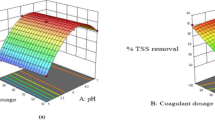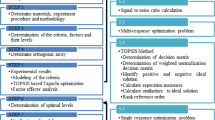Abstract
Cutting industries produce large quantities of wastewaters with the high content of suspended solids and turbidity. The treatments of these wastewaters are important in preventing the environmental pollution. This study aimed to optimize the use of coagulation and flocculation process by the response surface methodology (RSM) method as an effective method for the abatement of turbidity-related challenges of such wastewater using coagulants of Alum and polyaluminum chloride. This study is an analytical-applied. The synthetic wastewater with a turbidity of 170 ± 2 NTU at each stage of the jar test was used. The effect of Alum and PAC application was evaluated and compared each other as a function of settling time (40–140 min), pH (2–8), speed (20–60 rpm), and the coagulant dose (0–200 mg/l). In this study, the central composite design (CCD) was utilized to experimental design, modeling, and optimization of the turbidity removal from a stone cutting wastewater. A total of 33 experiments were designed for each coagulant. Results showed that the optimal conditions for turbidity removal were settling time, initial pH, speed, coagulant dosage, 40.98, 7.47, 55.44, 163.56–56.62, 7.93, 34.55, and 199.53 for Alum and PAC, respectively. Under these optimal values of process parameters, the dye removal efficiency of 100% and 98.84% was observed for Alum and PAC, respectively. The sum of squares model showed that the quadratic model is the best option for empirical data with the highest correlation coefficient (R2 of 0.99 and 0.98 for Alum and PAC, respectively.) and P value < 0.0001 for both models. The models can adequately describe the prominent behavior of turbidity removal process. Although a high turbidity removal was observed for application of the both coagulants, in real-scale selection, each of them is related to the operator conditions. Moreover, further investigations should be considered to generalization of this work results to the real-stone cutting wastewater. Besides, the TSS challenge of such wastewater should be solved before scaling-up the results.





Similar content being viewed by others
References
Asfaram, A., Ghaedi, M., Ghezelbash, G. R., & Pepe, F. (2017). Application of experimental design and derivative spectrophotometry methods in optimization and analysis of biosorption of binary mixtures of basic dyes from aqueous solutions. Ecotoxicology and Environmental Safety, 139, 219–227.
Bai, S.-W., Zhang, J.-S., & Wang, Z. (2015). A methodology for evaluating cleaner production in the stone processing industry: Case study of a Shandong stone processing firm. Journal of Cleaner Production, 102, 461–476.
Choy, S. Y., Prasad, K. M. N., Wu, T. Y., Raghunandan, M. E., & Ramanan, R. N. (2014). Utilization of plant-based natural coagulants as future alternatives towards sustainable water clarification. Journal of Environmental Sciences, 26(11), 2178–2189.
Choy, S. Y., Prasad, K. N., Wu, T. Y., Raghunandan, M. E., & Ramanan, R. N. (2016). Performance of conventional starches as natural coagulants for turbidity removal. Ecological Engineering, 94, 352–364.
Du, Q., Wei, H., Li, A., & Yang, H. (2017). Evaluation of the starch-based flocculants on flocculation of hairwork wastewater. The Science of the total environment., 601, 1628.
Fahiminia, M., Ardani, R., Hashemi, S., & Alizadeh, M. (2013). Wastewater treatment of stone cutting industries by coagulation process. Archives of Hygiene Sciences, 2(1), 16–22.
Foroughi, M., Arezoomand, H. R. S., Rahmani, A. R., Asgari, G., Nematollahi, D., Yetilmezsoy, K., et al. (2017). Electrodegradation of tetracycline using stainless steel net electrodes: Screening of main effective parameters and interactions by means of a two-level factorial design. Korean Journal of Chemical Engineering, 34(11), 2999–3008.
Foroughi, M., Chavoshi, S., Bagheri, M., Yetilmezsoy, K., & Samadi, M. T. (2018). Alum-based sludge (AbS) recycling for turbidity removal in drinking water treatment: an insight into statistical, technical, and health-related standpoints. Journal of Material Cycles and Waste Management, 20(4), 1999–2017.
Foroughi, M., Rahmani, A. R., Asgari, G., Nematollahi, D., Yetilmezsoy, K., & Samarghandi, M. R. (2018b). Optimization of a three-dimensional electrochemical system for tetracycline degradation using box-behnken design. Fresenius Environmental Bulletin, 27(3), 1914–1922.
Ghafari, S., Aziz, H. A., & Bashir, M. J. (2010). The use of poly-aluminum chloride and alum for the treatment of partially stabilized leachate: A comparative study. Desalination, 257(1–3), 110–116.
Ghafari, S., Aziz, H. A., Isa, M. H., & Zinatizadeh, A. A. (2009). Application of response surface methodology (RSM) to optimize coagulation–flocculation treatment of leachate using poly-aluminum chloride (PAC) and alum. Journal of Hazardous Materials, 163(2), 650–656.
Ghafoori, S., Mowla, A., Jahani, R., Mehrvar, M., & Chan, P. K. (2015). Sonophotolytic degradation of synthetic pharmaceutical wastewater: Statistical experimental design and modeling. Journal of Environmental Management, 150, 128–137.
Huang, S.-M., Kuo, C.-H., Chen, C.-A., Liu, Y.-C., & Shieh, C.-J. (2017). RSM and ANN modeling-based optimization approach for the development of ultrasound-assisted liposome encapsulation of piceid. Ultrasonics Sonochemistry, 36, 112–122.
Khiadani, M., Zarrabi, M., Foroughi, M. J. J. O. E. H. S., & Engineering. (2013). Urban runoff treatment using nano-sized iron oxide coated sand with and without magnetic field applying. Journal of Environmental Health Science and Engineering, 11(1), 43.
Kord, Mostafapoor F. (2008). Effectiveness of three coagulants of polyaluminum chloride, aluminum sulfate and ferric chloride in turbidity removal from drinking water. Zahedan Journal of Research in Medical Sciences, 10(2), 87–95.
Laitinen, N., Kulovaara, M., Levänen, E., Luonsi, A., Teilleria, N., & Nyström, M. (2002). Ultrafiltration of stone cutting mine wastewater with ceramic membranes—a case study. Desalination, 149(1), 121–125.
Liu, Z., Huang, M., Li, A., & Yang, H. (2017). Flocculation and antimicrobial properties of a cationized starch. Water Research, 119, 57–66.
McCurdy, K., Carlson, K., & Gregory, D. (2004). Floc morphology and cyclic shearing recovery: comparison of alum and polyaluminum chloride coagulants. Water Research, 38(2), 486–494.
Mehdinejad, M. H., Alimohammadi, N., Arbabmojeni, S., Soltani, A., & Amanbaei, A. (2014). Residual Aluminum from application of Alum and Polyaluminum Chloride in removal of turbidity from turbid water. Journal of Gorgan University of Medical Sciences, 16(1), 82–88.
Nasserdine, K., Mimi, Z., Bevan, B., & Elian, B. (2009). Environmental management of the stone cutting industry. Journal of Environmental Management, 90(1), 466–470.
Samarghandi, M. R., Khiadani, M., Foroughi, M., Nasab, H. Z. J. E. S., & Research P. (2016). Defluoridation of water using activated alumina in presence of natural organic matter via response surface methodology. Environmental Science and Pollution Research, 23(1), 887–897.
Shirazi, E.K., editor. (2011). Reusing of stone waste in various industrial activities. In: 2011 2nd International Conference on Environmental Science and Development IPCBEE.
Shokoohi, R., Asgari, G., Leili, M., Khiadani, M., Foroughi, M., & Hemmat, M. S. (2017). Modelling of moving bed biofilm reactor (MBBR) efficiency on hospital wastewater (HW) treatment: A comprehensive analysis on BOD and COD removal. International Journal of Environmental Science and Technology, 14(4), 841–852.
Subramonian, W., Wu, T. Y., & Chai, S.-P. (2014). A comprehensive study on coagulant performance and floc characterization of natural Cassia obtusifolia seed gum in treatment of raw pulp and paper mill effluent. Industrial Crops and Products, 61, 317–324.
Taheri, M., Moghaddam, M. A., & Arami, M. (2013). Techno-economical optimization of Reactive Blue 19 removal by combined electrocoagulation/coagulation process through MOPSO using RSM and ANFIS models. Journal of Environmental Management, 128, 798–806.
Teh, C. Y., Wu, T. Y., & Juan, J. C. (2014a). Potential use of rice starch in coagulation–flocculation process of agro-industrial wastewater: treatment performance and flocs characterization. Ecological Engineering, 71, 509–519.
Teh, C. Y., Wu, T. Y., & Juan, J. C. (2014b). Optimization of agro-industrial wastewater treatment using unmodified rice starch as a natural coagulant. Industrial Crops and Products, 56, 17–26.
Trinh, T. K., & Kang, L. S. (2011). Response surface methodological approach to optimize the coagulation–flocculation process in drinking water treatment. Chemical Engineering Research and Design, 89(7), 1126–1135.
Veisi, F., Zazouli, M. A., Ebrahimzadeh, M. A., Charati, J. Y., Dezfoli, A. S. J. E. S., & Research P. (2016). Photocatalytic degradation of furfural in aqueous solution by N-doped titanium dioxide nanoparticles. Environmental Science and Pollution Research, 23(21), 21846–21860.
Vepsäläinen, M., Ghiasvand, M., Selin, J., Pienimaa, J., Repo, E., Pulliainen, M., et al. (2009). Investigations of the effects of temperature and initial sample pH on natural organic matter (NOM) removal with electrocoagulation using response surface method (RSM). Separation and Purification Technology, 69(3), 255–261.
Wang, R.-M., Wang, Y., Ma, G.-P., He, Y.-F., & Zhao, Y.-Q. (2009). Efficiency of porous burnt-coke carrier on treatment of potato starch wastewater with an anaerobic–aerobic bioreactor. Chemical Engineering Journal, 148(1), 35–40.
Yahyapour, S., & Golshan, A. (2014). Removal of total suspended solids and turbidity within experimental vegetated channel: optimization through response surface methodology. Journal of Hydro-Environment Research., 8(3), 260–269.
Zazouli, M., Safarpour, M., Dobaradaran, S., & Veisi, F. (2015). Modeling of nitrate removal from aqueous solution by fe-doped TiO2 under UV and solar irradiation using response surface methodology. Global Nest Journal, 17(2), 379–388.
Author information
Authors and Affiliations
Corresponding author
Rights and permissions
About this article
Cite this article
Usefi, S., Asadi-Ghalhari, M. Optimization of turbidity removal by coagulation and flocculation process from synthetic stone cutting wastewater. Int J Energ Water Res 3, 33–41 (2019). https://doi.org/10.1007/s42108-019-00010-2
Received:
Accepted:
Published:
Issue Date:
DOI: https://doi.org/10.1007/s42108-019-00010-2




